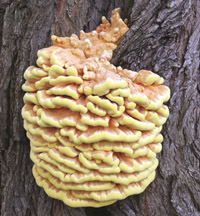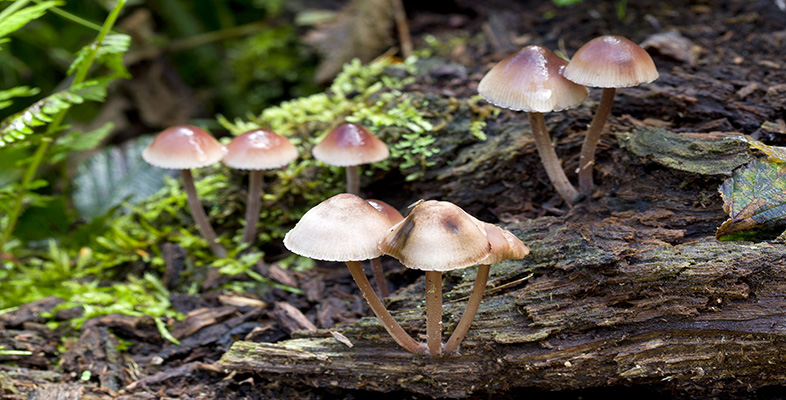2.2 The importance of ancient trees for specialist insects and fungi
Figure 6, as seen in the previous section, shows the range of features on the outside of ancient trees (such as deadwood on the ground, water pools, sap runs and holes) that provide habitats for the specialist species of lichen, fungi and insects. However, it is the process of hollowing by fungi that makes an ancient tree a habitat in its own right: the relatively stable temperature and humidity inside the tree provide the optimum environment for the growth of fungi and insect larvae. The sulphur polypore (Laetiporus sulphureus), a specialised wood decay fungus, softens the wood in the centre of the tree (Figure 7). As the wood decays, it becomes an attractive habitat for many rare invertebrates such as the hairy fungus beetle (Mycetophagus piceus) or the click beetles (Lacon querceus), the cardinal click beetle (Ampedus cardinalis) or the rusty click beetle (Elater ferrugineus). Some of these insects are so rare that they are known to exist at only one or two sites in the UK, such as some of the London parks and Windsor Great Park. The western wood-vase hoverfly (Myolepta potens) was thought to be extinct in the UK, since it had not been recorded for forty years – but larvae of this species were recently found in a pool of water in an ancient tree.
The various creatures and the fungi work together to recycle the dead wood, ensuring that the vital minerals and nutrients are pushed back down into the soil as a part of the rotting process, providing essential food for the trees' continued longevity.

The fungi and invertebrates found in ancient trees are so well adapted to the benign conditions within the trees that they cannot exist anywhere else. It can take 200 years for a tree to develop the conditions suitable for these organisms. Even trees as old as 100 years are unlikely to be suitable. Many of the specialist species dependent on ancient trees have poor powers of dispersal: if the tree they inhabit is destroyed it is unlikely that there will be another suitable tree nearby, so the effects of the loss of an ancient tree are irreversible.
Even in this ancient stage of its life, a tree may live for decades – even centuries. The older the tree, the more valuable it becomes as a habitat. The Major Oak in Sherwood Forest, which features in the clip, is perhaps the best known ancient tree in the UK. You can probably think of some examples of ancient trees near you.
Veteran trees are ancient trees of the near future. They have reached the mature phase of their lives and show signs of hollowing and decay. They often display a smaller selection of the same important wildlife and habitat features.
The UK is believed to have around 100,000 ancient and veteran trees – more than any other country in Europe. These trees are currently in the process of being recorded onto the Ancient Tree Hunt national inventory by volunteers. Unlike historic buildings, ancient or heritage trees have no specific legal safeguard. Without protection, ancient trees are often felled before any planning application is made. Trees with historic or biodiversity value can, however, be protected through Tree Preservation Orders (TPOs), or they may be situated within protected areas such as Sites of Special Scientific Interest (SSSI).
Question 4
Trees are large organisms that cast shade under their branches and provide microhabitats for other organisms. What other types of organism have been mentioned in this course?
Answer
Butterflies such as the silver washed fritillary (Argynnis paphia), saproxylic beetles, millipedes and fungi such as birch polypore fungus (Piptoporus betulinus).
